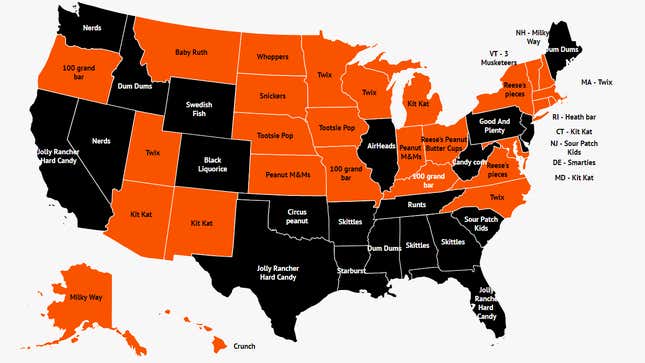
We at The Takeout cannot deny that we love drama—specifically, drama of the lowest order. Our staff is always coming up with ways to fabricate utterly inconsequential (and genial) discussions about our favorite foods, and we wouldn’t have it any other way. And there’s no better season for these (polite, friendly) debates than autumn, which kicks off a string of food-centric holidays, beginning with Halloween. Oh, how we wish we could keep up the (good-humored) sparring about Halloween candy all year long! We certainly do our best to make the (civil) squabbles last as far into October as possible.
Which brings us to Zippia’s map of America’s Favorite Candy By State, which we wrote about on Tuesday. ICYMI: Job hunting firm Zippia compiled Google Trends data on which candies were searched for the most in each state. The candy with highest volume of searches in a particular state, relative to the other states, was determined to be that state’s “favorite.” A data set as dubious as it is delicious, we say.
Eagle-eyed Takeout readers had questions and concerns about the map from the get-go, much to our delight. What follows is a brief digest of your commentary on the matter of America’s favorite Halloween candies. Your insights, as always, are invaluable.
Candy corn is good, actually
A lot of readers took issue with West Virginia’s high searches of candy corn. It’s a candy that divides the masses every year. But rather than get combative about it, user Vee took a different approach.
“You’re not buying the good stuff if you hate candy corn,” writes Vee. “Get the Brach’s seasonal bags.” Now I’m curious to see whether a specific brand really can sway us candy corn haters.
Jolly Ranchers in California? Really?
Many commenters were baffled by the fact that the most populous U.S. state, California, led the nation in searches for... Jolly Ranchers. And there were multiple theories on why this search term might have been uniquely high on the west coast.
- Weed sweets: User Bikesandtacos insists that anyone searching for Jolly Ranchers in California, where edibles are both legal and widespread, is searching for the THC equivalent, rather than the classic hard candy.
- Regional sway: While some Californians consider Jolly Ranchers an old-fashioned candy that has dwindled in popularity, LongJohnLoomis makes the point that it could be a specific region of the state swaying the search results. “I grew up in Southern California and Jolly Ranchers were constantly in demand,” they write. (Though you could argue this comment might be sarcastic...)
- Lack of availability: User Burners Baby Burners theorizes that people are searching for Jolly Ranchers in California because the candy has largely left the region. “The reason Jolly Rancher hard candy is being searched so much in California (and Texas) is that you can’t find them anymore,” they write. “About 3 years ago I went looking for any hard candy with fruit flavor, and all I could find were gummy versions of the classics. They’re not super popular moreso than any other top-tier candy, they simply aren’t around.”
Reese’s Pieces aren’t chocolate!
We really have to hand it to Takeout readers for noticing what we ourselves failed to: New York and Virginia are miscategorized! The map is color-coded by each state’s Halloween candy preference, with orange states indicating a chocolate candy and black states indicating a non-chocolate candy. However, the two states that list Reese’s Pieces as the “most popular” candy (again, based on search volume) are shown in orange. And Reese’s Pieces contain no chocolate! The shell encasing the peanut butter center is just a candy coating, not a chocolate one. A whole bunch of folks pointed this out, and your scrupulousness is much appreciated.
Why would multiple states have the same result?
Multiple commenters, including at least one alleged data analyst, pointed out that if the results indicate which candies were “most uniquely searched” by each state, then it’s odd that some states share the same candy.
We reached out to Zippia about this, and it has to do with the fact that the data was pulled from a limited number of candies. A total of 63 candies were assessed for disproportionate searches in a given state. If there was a tie between multiple candies, then a secondary statistic, search volume, broke the tie. In some states, the tiebreaker ended up being the same candy.
The map aims to show each state’s favorite candy—but it might show the exact opposite
Many readers pointed out what might be a fundamental flaw in this fun, sugary data set: if a state is Googling a particular candy with the most frequency, that doesn’t necessarily mean it’s a popular candy. Indeed, it could mean the candy is so unpopular in that region that people are Googling it just to clarify what the hell it is.
“What a strange method,” writes user SteveDave. “Who the hell is out there googling ‘Twix’? Like, does anyone normally google things they love?” Excellent point.
User featherlite puts it another way: “Someone could be Googling candy they would never eat but are just curious about.”
“The states that have 100 Grand candy bars as their ‘favorite’ are just from people checking Google to see if they still exist,” writes Collimat.
It’s true that there are limits to the amount of meaningful data that can be gleaned from Google Trends. But look, aren’t we all happy to be given an excuse to think about Halloween candy this deeply? And even if the map is indicating something beyond candy preferences, isn’t it fun to speculate on what that might be? Aren’t we all just a little happier than we were before Halloween candy season rolled around?
If you need me, I’ll be Googling “Airheads” to determine why my home state might have a particular fascination with them. I don’t think there’s anything new I could possibly learn about Airheads, but by god, I’m willing to try.